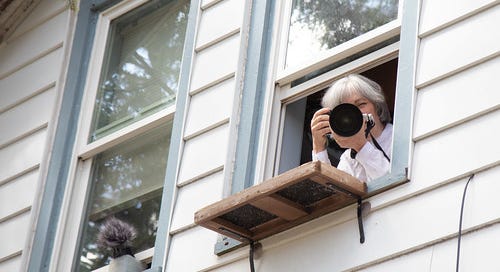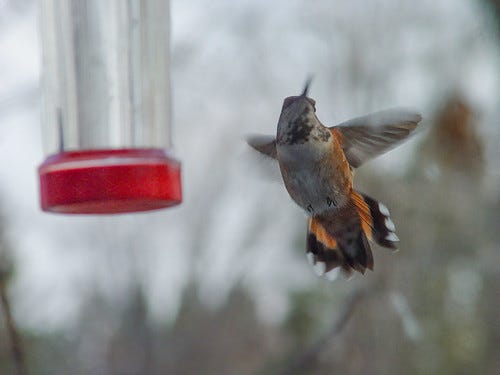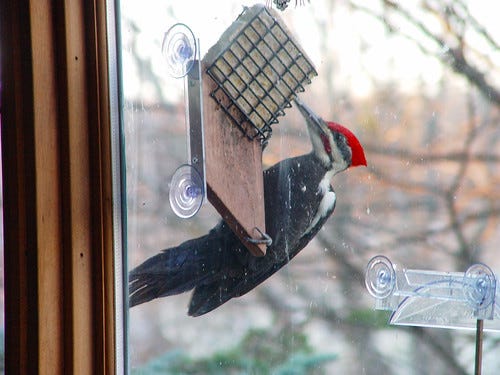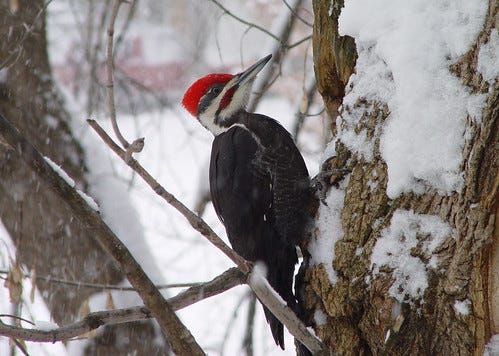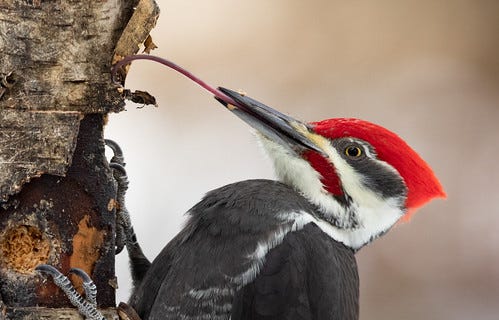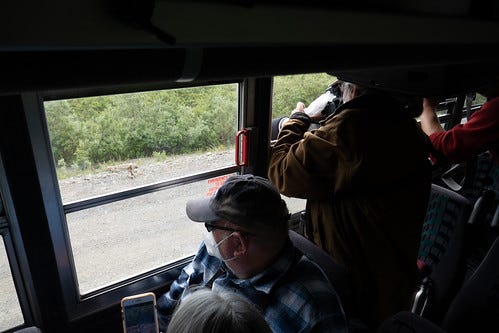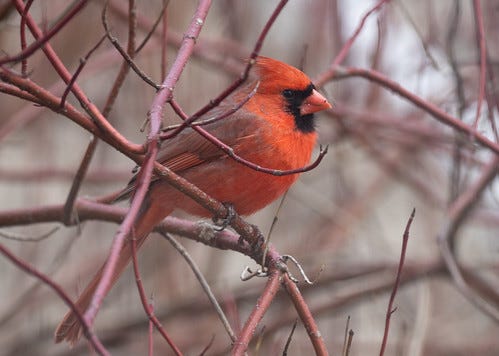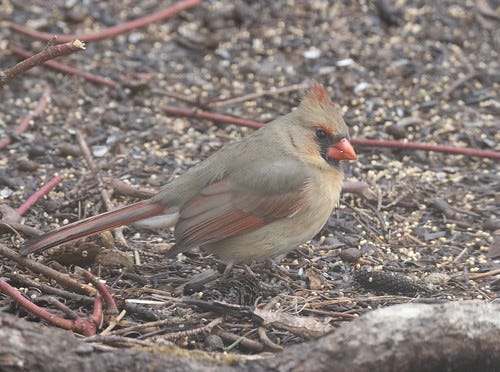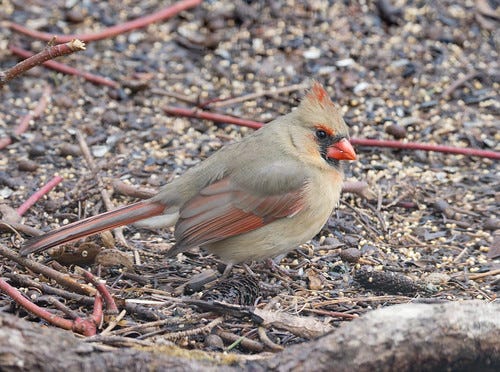(Listen to the radio version here.)
At the moment I started writing this, on April 15, it was snowing. As long as it stays above 20º or so outside, our heat pump provides all our heating (our gas furnace switches on when temps drop into the teens), but we don’t like squandering energy, so we’re keeping our windows tightly closed.
But at 8:43 am Saturday, April 12, while I was working at my computer, I suddenly heard Sandhill Cranes flying over. They must have been right overhead because the sound came through the closed window while the noisy heat pump was working. I looked out but couldn’t see them and didn’t want to report them to eBird without confirmation—my hearing is bad enough even without a closed window and heat pump noise between me and a bird. So I grabbed my cellphone and turned on my “Terra Listens” app. I have a “Terra Station”1 set up outside my office window which is always listening to the birds in my yard, listing them on my phone app in real time. Sure enough, the exact same minute that I heard those cranes, Terra had heard them, too.
If I’m paying attention to the Terra feed when it reports a bird I can’t hear anymore, such as a Brown Creeper or Golden-crowned Kinglet, I look out the window or charge outside with my binoculars to confirm. Terra’s identifications are hardly perfect: one night a few months ago, it reported a Barn Owl when chances of one flying over Peabody Street, much less calling out within hearing range of my house, are vanishingly small—the species is considered “accidental” for the entire state, and there have been only three reports EVER of Barn Owls in my very large county.
A few times, Terra has reported a Pileated Woodpecker calling in the middle of the night, which again is extremely improbable. And on the very screen reporting my Sandhill Cranes, Terra shows a Chipping Sparrow from April 11. This would be exceptionally early for them and I saw that report as it happened, so I went out to verify but there were only juncos, whose song can be mistaken for a chippie by even fairly experienced birders. But I learned long ago never to make the perfect the enemy of the good. The cut-off between an A and a B when I was in school was 93 percent, and Terra easily meets that standard.
Hearing birds through a closed window is tricky, but looking at them is another matter, so I keep binoculars close to all our good windows. But a camera? I used to think photographing through a closed window would never give me acceptable photos except for documentation. Most of the photos I managed to get of a Rufous Hummingbird visiting in November and early December 2004 were through the closed window, and they were nothing to write home about.
The Minnesota Ornithologists’ Union wouldn’t accept anyone’s photos as documentation of that bird down to species—digital cameras were just not good enough yet. So the official records call my little hummer Selasphorus sp. But that was more about cameras than the window.
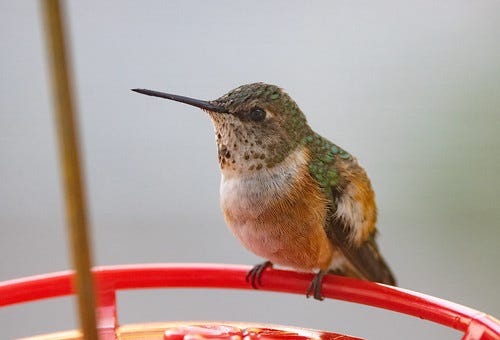
The same year my first Rufous Hummingbird showed up, a Pileated Woodpecker was frequenting my small window suet feeder. He was a messy eater and gooped up the window, but I still like my photos just because.
During a blizzard when I opened the window hoping the hummingbird could feed inside (no dice—she preferred the natural world) the Pileated showed up and let me take his photo without any glass blocking the way. That was thrilling.
The very best photo I ever took through window glass was also of a Pileated. We’d just had a new window installed in our dining room—the men were hardly out the door—and I grabbed my camera to photograph the first bird to show up just to see how it turned out through a spanking new window, when instantly in flew a male Pileated. I held down the shutter in “burst mode,” and WHOA! I got a magazine-quality image of his tongue fully extended!
Even when conditions are exactly right for taking a photo out the window, it’s much better if the window is open, no glass between the camera lens and the bird. When Russ and I were on the National Park Service tour bus in Denali National Park, I opened my window and stuck my camera out to get photos of a nearby Willow Ptarmigan as Russ took pictures of me doing that.
This week a male and female cardinal turned up in my backyard near the window where I keep the camera I mostly just use for backyard photography. It has an 800-mm lens so I need a tripod to hold it steady, which is why I don’t normally lug it around when I’m birding. And the longer the lens, the trickier the shots are through glass, so I usually use it on my patio or I open that window when I’m going to sit for a while. But unlatching and opening the window always scares birds off so I took these photos through the glass.
I haven’t cleaned the windows yet this spring, and I was shooting at an angle (you’re shooting through the least amount of glass, so get the least distortion, when the camera is perpendicular and very close to the window). I edit and organize my photos using Adobe Lightroom, and one thing I figured out a few years ago when I take a window shot is to use a process called “Dehaze” to get rid of some of the window effect. My shots of the male cardinal weren’t bad even without that, but the photos of the female look significantly clearer after processing.
I’m pretty sure the New Testament Paul was not thinking about windows when he wrote in I Corinthians, “For now we see through a glass, darkly.” Historians believe windows were invented in ancient Rome around the year 100 AD; Paul died about 35 years earlier. But window glass can darken our photos in addition to killing a billion or so birds here in America every year, darkening the world for all of us. (Ways you can reduce window kills at your own windows are listed here.) Photos of living birds through glass, with practice and sometimes a little processing, can at least lighten our hearts.
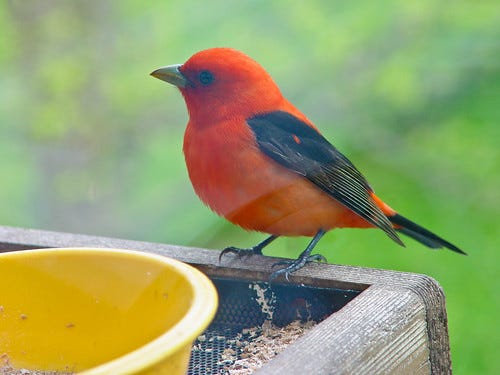
A few years ago, I donated to a kickstarter campaign to fund the development of an affordable bioacoustic monitor that, with a free app (“Terra Listens”), allows people to identify every audible bird in, near, or flying over our backyards in real time, 24-7. I received mine a few months ago. It runs on electricity so I have mine on the top of my office air conditioner for now, but when they get all their backorders filled, I’ll be getting an attachment so it can run on solar energy. Then I can place it in the backyard.


